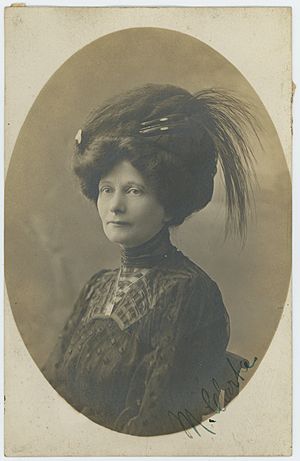Mary Jane Clarke facts for kids
Quick facts for kids
Mary Jane Clarke
|
|
|---|---|
 |
|
| Born |
Mary Jane Goulden
1862 Salford, Manchester, England
|
| Died | 1910 (aged 47–48) London, England
|
| Nationality | British |
| Occupation | Suffragette |
| Known for | first suffragette to die for the cause |
| Spouse(s) |
John Clarke
(m. 1895–1904) |
| Parent(s) |
|
| Relatives | Emmeline Pankhurst (sister) |
Mary Jane Clarke (born Mary Jane Goulden; 1862– 1910) was a brave British suffragette. Suffragettes were women who fought for the right to vote. She sadly died on Christmas Day in 1910. This was just two days after she was let out of prison. She had faced very difficult conditions there. Many people called her the suffragettes' "first woman martyr." This means she was seen as someone who died for their cause. Mary Jane was also the younger sister of the famous suffragette Emmeline Pankhurst.
Contents
Early Life and Family
Clarke was born in Salford, England, in 1862. She was one of ten children. Her older sister was Emmeline Pankhurst. Their parents were Robert and Sophia (née Craine). Robert worked his way up in a cotton-printing company. Sophia was a teacher. She greatly influenced her daughters' ideas about politics.
The Goulden family had a history of political involvement. Mary Jane studied in Paris, France, at the École Normale Supérieure. Her sister Emmeline also studied there. Later, Mary Jane helped Emmeline open a shop called Emerson & Co. in London. Mary Jane was a "decorative artist." She helped decorate the shop's fancy goods. In 1895, she married John Clarke. By 1904, she lived with her niece, Sylvia Pankhurst.
Fighting for Women's Rights
Mary Jane Clarke worked as a deputy for Emmeline Pankhurst in Manchester. At the same time, she supported the Women's Social and Political Union (WSPU). The WSPU was a leading group fighting for women's right to vote. By 1906, she worked full-time for the WSPU. In 1907, she became an organizer for the group.
In 1909, Mary Jane led a group of suffragettes to Downing Street in London. This is where the Prime Minister lives. She was arrested and sent to prison for one month. For her bravery, Clarke was given a Hunger Strike Medal.
After being released, Clarke gave speeches for the WSPU in Yorkshire. By summer 1909, she was an organizer in Brighton. She was known for being calm and controlled, even when people shouted at her.
Protests and Imprisonment
Mary Jane Clarke was admired by other suffragettes. Joan Dugdale praised her "superhuman strength of spirit." She also noted Mary Jane's "sweet sympathy and gentleness." This was especially true after they were hurt by an angry crowd in Bournemouth.
Clarke also took part in a big protest on 18 November 1910. This day became known as Black Friday (1910). Many women were hurt by the police during this protest. A few days later, on 23 November 1910, Mary Jane was arrested. She was arrested for breaking windows. She was sent to HM Prison Holloway for a month. While in prison, she faced very difficult conditions.
Mary Jane Clarke was released from prison on 23 December 1910. She spoke at a suffragette event. Then she traveled to Brighton for another meeting. She returned to London and sadly died two days later. She passed away on Christmas Day, 25 December 1910. She was at her brother's home in Winchmore Hill, London. Emmeline Pethick-Lawrence wrote that Mary Jane was "the first woman martyr who has gone to death for this cause."
In January 1911, suffragette leader Annie Kenney planted a special tree for Mary Jane. It was a memorial tree in the garden of the Blathwayts' Eagle House in Somerset. This place was known as the Suffragette's Rest.
Legacy and Memorial
In 2018, a campaign started to build a statue of Mary Jane Clarke. The statue would be in the Pavilion Gardens in Brighton. A design by sculptor Denise Dutton was approved in 2020. The statue aims to be "an image of female courage and political leadership." It will encourage women and girls to take part in public life. It will also help people understand women's history better.
The statue design includes references to her activism. It shows the Votes for Women newspaper and her Hunger Strike Medal. It also includes words from Emmeline Pankhurst: "She is the first to die. How many must follow…" The statue will have "a lamp at her feet which she has placed there for others to pick up." The Mary Clarke Statue Appeal is raising money for the project. Jean Calder, the chair, said that women who achieve a lot are often not remembered. She felt Mary Jane made a huge sacrifice but was forgotten.
Images for kids
-
Annie Kenney (left) and other suffragettes planting memorial trees at Eagle House.



